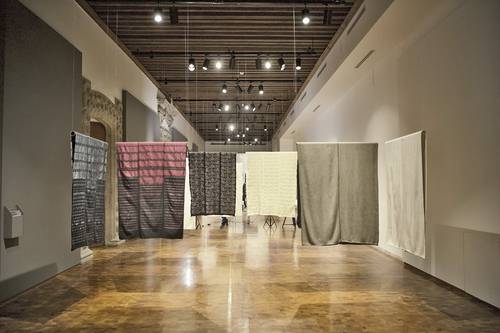The huipils of the exhibition Day and night They capture the yin and yang in the Mexican style
The huipils of the project Day and night they turn out to be a second skin
, says Remigio Mestas, Oaxacan researcher and cultural manager. Achieving them is equivalent to a ritual
even a meditation
, since its completion can take up to six months. Due to the thickness of the threads involved, very thin gauges, It seems that the fabric is never finished, that it is a long process
says Mestas to The Conference about the exhibition Day and night: The magic of Oaxaca textiles, at the Citibanamex-Palacio de Iturbide Cultural Palace.
The sample of 16 pairs of huipils (one white and one black) is complemented by another 21 from the Fomento Cultural Banamex collection, made by the same artisan hands, almost all of them women.
With the opening of Day and night, as well as Atlas, exhibition by Jan Hendrix, a Mexican artist of Dutch origin, began the celebrations for the 140 years of the National Bank of Mexico, at the Iturbide Palace.
Day and night It began on a trip that Mestas – born in the Zapotec town of Villa Hidalgo, municipality of Yalalag – made to China, following The Silk Road
. He returned very impressed and with the idea of making a textile collection in which we can capture the yin and yang in the Mexican way
.
For Mestas, mythologies are of great relevance: “In Mixe mythology, women are an important character. Legend has it that a hummingbird suddenly came and stung a woman’s chest while she was knitting. She looked for it, but she was no longer there, so she wove it on her backstrap loom. At nine months she gave birth to twins who went to the mountains, where they became the two-headed bird which, in turn, ascended higher and became the Sun and the Moon. From there arises the theme of Day and night, in a comparison to yin and yang.”
In the 90s, Mestas started this project to rescue, promote and value the artisan traditions existing in the 15 native towns of Oaxaca. To do this, he has had the support of artisans such as Nicolasa Pascual, from San Bartolo Yautepec; Francisca Palafox, from San Mateo del Mar, Tehuantepec; Natalia López, from Santa María Peñoles, Etla, and Bagelia Bautista, from Pinotepa de Don Luis, Jamiltepec, with whom We took on the adventure of making a warp and a weft that unites four continents: Asia, Africa, Europe and America
.
In Day and night materials from different parts of the world they are sisters
with the Oaxacan strands in order to weaving the identity of each of the indigenous peoples
Of the entity.
Over three decades, We have worked to keep alive the identity of the native peoples. For example, in a Zapotec huipil from my town, Yalalag, we cannot distort the goddess of 13 snakes with another icon from abroad.
.
Regarding the current strength of the weaving tradition in Oaxaca, Mestas reflects that neither the Conquest nor the covid could disappear it; so, We are proud to be native and maintain our identity. A few years ago, at an activity in Mexico City, I found more young people knitting when I thought there would be only veterans. I see that there is pride, and it is thanks to all this resistance to keep the tradition alive, and that the weaving has been dignified over the years
.
Although there is no census regarding how many people weave in Oaxaca, he assures that there one can lift a stone and there will be a master painter and many more artisans, because popular art is alive. It seems that this ancient world, weaving on a rudimentary tool like the backstrap loom, has not passed
.
The exhibitions Day and night: The magic of textiles in Oaxaca, y Atlas, They will remain until September 29 at the Citibanamex-Palacio de Iturbide Cultural Palace (Madero 17, Historic Center).
